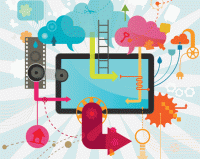Using Technology to Reach Unreachable Students
The iPad made a transformation in John's learning demeanor. Where once his attitude blared, "I dare you to teach me!" now it screams, " Teach me more!" Wouldn't that be a great story to be able to tell? It would be solid proof that technology transforms learning and teaching (this is the motto of our school this year). Unfortunately, these types of examples are rare. What we have typically seen up to now with the computer revolution, is a temporary interest piqued by an engaging program or computer game, but then followed by a general disinterest.
The iPads are a different story, however...
One ninth grade teacher at Southside High School mentioned that she noticed that students that normally do not participate in class discussions are being very active in electronic discussions. I noticed the same thing in my online classes at the University of Phoenix. Where in a regular classroom setting, I would allow others to monopolize the conversations, in an electronic setting, I found that I had significant things to offer, and I could present well prepared arguments for my ideas.
With iPad in hand, I have witnessed a student who normally has minimal attention span, carefully construct his dream mansion, brick-by-brick. I have seen a student who would rather run laps rather than read books, open the electronic version of Lord of the Flies and start reading for understanding. I saw a student who struggles to compose complete sentences, labor over a paragraph until she got it just right in order to send it to her teacher. The iPad is transforming how our students are learning.
In a study done in England at the ACS Cobham School, 65 first- and second-graders were given iPads to use and, after the newness of the device wore off, they evaluated the students on three categories: engagement, collaboration, and perseverance (Harrold, 2012). What they discovered was that in every instance, when compared with the control groups, iPad enabled students were rated higher in each category. Interestingly enough, they also discovered that first- and second- graders found it easier to type on the iPad than on the computer keyboard. Whether that is because their hands were smaller or that the students did not have to unlearn touch-typing is yet to be determined.
I asked two of my tenth grade students, "Do you feel smarter now that you have an iPad to use?" They both actually said yes. "Any question we have, we simply type it in and can find the answer, instantly!" "I don't have to wait for the teacher any more." The flip side of the iPad implementation at Southside is that we still have a few students who want to push the rules: downloading things they shouldn't and deleting the control software.
In general, however, students are using the iPads the right way, on the right things because the teachers have given them a reason to use them. Edmodo classrooms are proliferating across the campus and teachers are keeping one step ahead of the students in finding apps that fit their curricular needs. One app the teachers are using is called Teacherkit and helps teachers to keep track of the soft measures of student performance, like engagement, interaction, collaboration, and interest. Most importantly, it helps the teacher keep tabs on the students that like to stay beneath the radar and helps them bring them into the learning network.
Because of the influence, transformation, and evolution of teaching and learning brought on by mobile learning devices like the iPad, and dedicated professionals who are taking advantage of the device capabilities, I hope to be able to report that students who one time refused to learn, now are eager to learn.
What inspiring stories can you share about your students and technology?
Reference
Harrold, R. (2012). Measuring the Effect of iPads in the Classroom. International Educator, 26(4).
